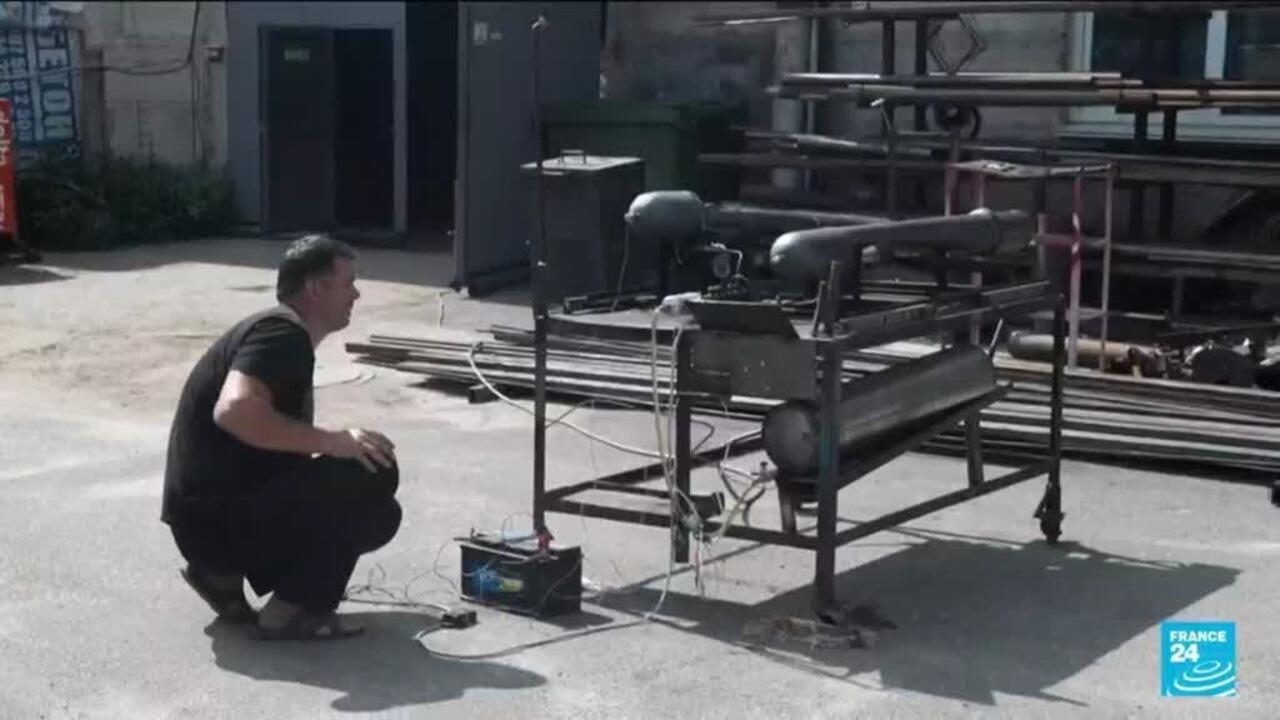The “trembita”, a traditional Ukrainian mountain horn, is also the name of a cruise missile developed by volunteers in Ukraine, who say it will be hundreds of times cheaper than Western equivalents.
“Rockets with warheads will have more expensive electronics so they can hit targets accurately,” explains Serhii, a volunteer with the Pars design bureau.
“But thousands of decoys will be very cheap: we want to overwhelm the Russians’ air defences so that our attack rockets hit their targets,” he says.
A group of volunteers from elsewhere in Ukraine watch a demonstration of the missile. They are interested in helping to make Trembitas in multiple locations.
“I’m very happy that this kind of production is developing in Ukraine,” says Yulia, a volunteer from the Kyiv region. “And I like how these weapons are all designed to let soldiers operate further away from the front line.”
Russia has been using this approach for a while with the cheap Iranian Shahed-136 loitering munitions.
The problem is that self-propelled antiaircraft guns, SPAAGs, are a cheap way to take down relatively low and slow weapons like this.
In the US, we mostly shifted away from SPAAGs to surface-to-air missiles when aircraft shifted to jets; SPAAGs were fairly obsolete against them. By this point, our SPAAGs have all been out of service – and not just out of service, but dismantled and sold off for parts – for decades, and the fact that Germany was somewhat slow to abandon them made their Gepard SPAAGs
useful in Ukraine against Shahed-136s.https://en.wikipedia.org/wiki/M163_VADS
The M163 Vulcan Air Defense System (VADS) is a self-propelled anti-aircraft gun (SPAAG) that was used by the United States Army.
With the wider use of non-jet-based low-and-slow cheap unmanned weapons, the SPAAG is better-suited as a counter to those.
However, the Soviet Union was slower to abandon SPAAGs, and Russia tends to warehouse a lot of older weapons, moreso than we do. They are probably better positioned to counter such weapons then we are to provide Ukraine with air defenses against them. We’ve mostly been relying on sending elderly Hawk SAMs, which are obsolete against current aircraft but work against Shahed-136s and are numerous enough that they’ll last for a while.
[continued in child]
[continued from parent]
https://en.wikipedia.org/wiki/Self-propelled_anti-aircraft_weapon
The introduction of jet engines and the subsequent rough doubling of aircraft speeds greatly reduced the effectiveness of the SPAAG against attack aircraft.[dubious – discuss] A typical SPAAG round might have a muzzle velocity on the order of 1,000 metres per second (3,300 ft/s) and might take as long as two to three seconds to reach a target at its maximum range. An aircraft flying at 1,000 kilometres per hour (620 mph) is moving at a rate of about 280 metres per second (920 ft/s). This means the aircraft will have moved hundreds of meters during the flight time of the shells, greatly complicating the aiming problem to the point where close passes were essentially impossible to aim using manual gunsights. This speed also allowed the aircraft to rapidly fly out of range of the guns; even if the aircraft passes directly over the SPAAG, it would be within its firing radius for under 30 seconds.
SPAAG development continued through the early 1950s with ever-larger guns, improving the range and allowing the engagement to take place at longer distances where the crossing angle was smaller and aiming was easier. Examples including the 40 mm U.S. M42 Duster and the 57 mm Soviet ZSU-57-2. However, both were essentially obsolete before they entered service, and found employment solely in the ground-support role. The M42 was introduced to the Vietnam War to counter an expected North Vietnamese air offensive, but when this failed to materialize it was used as an effective direct-fire weapon. The ZSU-57 found similar use in the Yugoslav Wars, where its high-angle fire was useful in the mountainous terrain.
By the late 1950s, the US Army had given up on the SPAAG concept, considering all gun-based weapons to be useless against modern aircraft. This belief was generally held by many forces, and the anti-aircraft role turned almost exclusively to missile systems. The Soviet Union remained an outlier, beginning the development of a new SPAAG in 1957, which emerged as the ZSU-23-4 in 1965. This system included search-and-track radars, fire control, and automatic gun-laying, greatly increasing its effectiveness against modern targets. The ZSU-23 proved very effective when used in concert with SAMs; the presence of SAMs forced aircraft to fly low to avoid their radars, placing them within range of the ZSUs.
The success of the ZSU-23 led to a resurgence of SPAAG development. This was also prompted by the introduction of attack helicopters in the 1970s, which could hide behind terrain and then “pop up” for an attack lasting only a few tens of seconds; missiles were ineffective at low altitudes, while the helicopters would often be within range of the guns for a rapid counterattack. Notable among these later systems is the German Gepard, the first western SPAAG to offer performance equal to or better than the ZSU. This system was widely copied in various NATO forces.
SPAAG development continues, with many modern examples often combining both guns and short-range missiles. Examples include the Soviet/Russian Tunguska-M1, which supplanted the ZSU-23 in service, the newer versions of the Gepard, the Chinese Type 95 SPAAA, and the British Marksman turret, which can be used on a wide variety of platforms. Some forces, like the US Army and USMC have mostly forgone self-propelled guns in favor of systems with short-range infrared-guided surface-to-air missiles in the AN/TWQ-1 Avenger and M6 Linebacker, which do not require radar to be accurate and are generally more reliable and cost-effective to field, though their ability to provide ground support is more limited. The U.S. Army did use the M163 VADS and developed the prototype design of the M247 Sergeant York.
The moment Russians hear “Riiii-colllla!,” they know they’re doomed.




